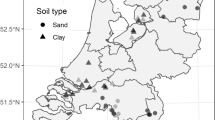Abstract
Potassium (K) fertilizer form (liquid or granular), source (chloride or sulfate), and time of application (preplant or in-season) were evaluated for effects on potato tuber yield and quality in Washington’s Columbia Basin. Potato yield and quality did not respond positively to potassium fertilizer although pre-plant soil-test K values were in the range where adding K fertilizer is recommended in the current (1999) Washington guidelines. In one of three years, total tuber yield was reduced with inseason fertilization with potassium chloride and with 75% in-season liquid K application. While the results were inconsistent over growing seasons, a few of the in-season, liquid K fertilizer treatments resulted in a significant reduction in percent marketable yield. Thus, the study results uphold the current practice of using granular K fertilizers pre-plant. In addition, the results of this study strongly indicate that K source does not affect tuber specific gravity. The limited response of yield and quality factors to K fertilizer on sites that Washington’s current soil-test and K fertilizer guidelines indicate should be K responsive suggest that further research is needed to fine tune the guidelines
Resumen
Se evaluaron los efectos que conlleva la forma de fertilizar con potasio (liquida o granular), fuente (cloruro o sulfato) y tiempo de aplicación (antes de la siembra o en forma oportuna), sobre los rendimientos de los tubérculos y calidad de la variedad Washington’s Columbia Basin. Ni el rendimiento ni la calidad respondieron positivamente a la fertilizatión con potasio, pese a que un análisis de suelo antes de la siembra, para determinar el valor de K, estuvo dentro del rango recomendado para fertilizar con potasio, de acuerdo a las pautas vigentes de la variedad Washington (1999). En uno de los tres años, el rendimiento total de los tubérculos se redujo con la fertilización oportuna con cloruro de potasio y en 75% con la aplicación oportuna de potasio líquido Mientras que los resultados fueron contradictorios durante la temporada de crecimiento, y menores a los de la fertilización oportuna, los tratamientos de fertilización con K liquido conllevaron una reductión significativa sobre el porcentaje de rendimientos comerciales. Así, los resultados del estudio apoyan la práctica actual de usar fertilización granular de K en el período previo a la siembra. Adicionalmente, el resultado de este estudio indica contundentemente que la fuente de K no afecta la gravedad específica del tubérculo. La limitada respuesta de los factores de rendimiento y calidad a la fertilización con K en aquellos lugares donde los análisis de suelo y las pautas de fertilización con K de la variedad Washington indican que debería haber correspondencia al K, sugiere que se requieren más investigaciones para definir mejor dichas pautas
Similar content being viewed by others
Literature Cited
Cate, R.B., and L.A. Nelson. 1971. A simple statistical procedure for partitioning soil test correlation data into two classes. Soil Sci Soc Am Proc 35:658–660.
Dean, B.B. 1999. The gravity of specific gravities (the 1999 season).In: Proc. 38th Ann. Washington State Potato Conference and Trade Show. Moses Lake, WA. February 2–4,1999.
Dunn, L.E., and R.E. Nylund. 1945. The influence of fertilizers on the specific gravity of potatoes grown in Minnesota. Am Potato J 22:275–288.
Galvak, R.G., D.A. Horneck, and R.O. Miller. 1994. Plant, soil and water reference methods for the Western region. Western Regional Educ.Pub. 125.
Gavlak, R.G., D.T. Westermann, and B.D. Brown. 1989. Potassium fertilizer needs in southern Idaho. Proc. 40th Annual Far West Regional Fert. Conf. pp. 89–97.
Jackson, T. 1983. Relating potassium response to soil and plant analyses values in Oregon. 34th Annual NW Fertilizer Conference. July 12–13,1983. pp. 99–103.
Jackson, T.L., M.L. Powelson, M.J. Johnson, S. James, and D. Sullivan. 1982. Fertilizers do affect potato diseases.In: Proc. 21st Washington Potato Conference and Trade Fair. Moses Lake, WA. February 1982. pp. 85–93
Lang, N.S., and R.G. Stevens. 1997. Survey of central Washington fertilizer recommendations.In: Proc. 36th Washington Potato Conference and Trade Show. Moses Lake, WA. February 4–6, 1997.
Lang, N.S., R.G. Stevens, R.E. Thornton, W.L. Pan, and S. Victory. 1999. Irrigated potato nutrient management guide for central Washington. Wash. State Univ. Extension Bulletin #241.
McDole, R.E. 1978. Potassium fertilizer trials with potatoes on coarsetextured soils in southeastern Idaho. Am Potato J 55:161–170.
Murphy, H.J., and M.J. Goven. 1966. The last decade in 38 years of potash studies for potato fertilizers in Maine. Am Potato J 43:122–127.
Panique, E., K.A. Kelling, E.E. Schulte, D.E. Hero, W.R. Stevenson, and R.V. James. 1997. Potassium rate and source effects on potato yield, quality and disease interaction. Am Potato J 74:379–398.
Roberts, S. 1983. Relating Phosphorus and potassium response of potatoes to soil and tissue tests.In: 34th Annual NW Fertilizer Conference. Portland, OR. July 12–13, 1983. pp. 81–87.
Rykbost, K.A., N.W. Christenen, and J. Maxwell. 1993. Fertilization of Russet Burbank in short-season environment. Am Potato J 70:699–710.
SAS Institute. 1998. SAS/STAT user’s guide for personal computers, Ver. 8. SAS Inst, Cary, NC.
Westermann, D.T., D.W. James, T.A. Tindall, and R.L. Hurst. 1994a. Nitrogen and potassium fertilization of potatoes: Sugars and starch. Am Potato J 71:433–452.
Westermann, D.T., T.A. Tindall, D.W. James, and R.L. Hurst. 1994b. Nitrogen and potassium fertilization of potatoes: Yield and specific gravity. Am Potato J 71:417–432.
Westermann, D.T., and T.A. Tindall. 1995. Managing potassium in potato production systems of Idaho. Proc. Idaho Potato School. pp. 201–242.
Wilcox, G.E. 1961. Effect of sulfate and chloride sources and rates of potassium on potato growth and tuber quality. Am Potato J 38:215–220.
Wright, R.J., and T.I. Stuczynski. 1996. Atomic absorption and flame emission spectrometry.In: Bigham, J.M. (ed), Methods of Soil Analysis Part 3: Chemical Methods. Soil Sci. Soc. AM. Book Series No. 5, Soil Sci. Soc. Am, Madison, WI. pp. 65–90.
Author information
Authors and Affiliations
Corresponding author
Rights and permissions
About this article
Cite this article
Davenport, J.R., Bentley, E.M. Does potassium fertilizer form, source, and time of application influence potato yield and quality in the Columbia Basin?. Amer J of Potato Res 78, 311–318 (2001). https://doi.org/10.1007/BF02875696
Accepted:
Issue Date:
DOI: https://doi.org/10.1007/BF02875696




